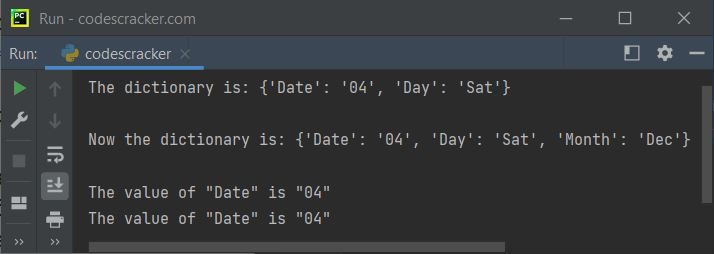- Python Built-in Functions
- Python All Built-in Functions
- Python print() Function
- Python input() Function
- Python int() Function
- Python float() Function
- Python len() Function
- Python range() Function
- Python str() Function
- Python ord() Function
- Python chr() Function
- Python ascii() Function
- Python pow() Function
- Python type() Function
- Python List Functions
- Python list() Function
- Python insert() Function
- Python append() Function
- Python extend() Function
- Python pop() Function
- Python remove() Function
- Python reverse() Function
- Python sort() Function
- Python sorted() Function
- Python Dictionary Functions
- Python dict() Function
- Python update() Function
- Python get() Function
- Python keys() Function
- Python setdefault() Function
- Python fromkeys() Function
- Python items() Function
- Python popitem() Function
- Python Tuple Function
- Python tuple() Function
- Python Set Functions
- Python set() Function
- Python frozenset() Function
- Python String Functions
- Python split() Function
- Python join() Function
- Python format() Function
- Python replace() Function
- Python Iterator Functions
- Python iter() Function
- Python min() Function
- Python max() Function
- Python sum() Function
- Python count() Function
- Python index() Function
- Python copy() Function
- Python clear() Function
- Python next() Function
- Python filter() Function
- Python enumerate() Function
- Python zip() Function
- Python reversed() Function
- Python Number Functions
- Python abs() Function
- Python bin() Function
- Python oct() Function
- Python hex() Function
- Python round() Function
- Python divmod() Function
- Python complex() Function
- Python File Handling Functions
- Python open() Function
- Python read() Function
- Python readable() Function
- Python readline() Function
- Python readlines() Function
- Python write() Function
- Python writable() Function
- Python writelines() Function
- Python close() Function
- Python seek() Function
- Python tell() Function
- Python flush() Function
- Python fileno() Function
- Python truncate() Function
- Python Class Functions
- Python object() Function
- Python property() Function
- Python getattr() Function
- Python setattr() Function
- Python hasattr() Function
- Python delattr() Function
- Python classmethod() Function
- Python staticmethod() Function
- Python issubclass() Function
- Python super() Function
- Python Misc Functions
- Python all() Function
- Python any() Function
- Python isatty() Function
- Python bool() Function
- Python callable() Function
- Python globals() Function
- Python locals() Function
- Python dir() Function
- Python id() Function
- Python isinstance() Function
- Python map() Function
- Python repr() Function
- Python slice() Function
- Python vars() Function
- Python Advance Functions
- Python help() Function
- Python hash() Function
- Python breakpoint() Function
- Python bytes() Function
- Python bytearray() Function
- Python memoryview() Function
- Python compile() Function
- Python eval() Function
- Python exec() Function
- Python Tutorial
- Python Tutorial
- Python Examples
- Python Examples
Python setdefault() Function
The setdefault() function in Python returns the value of given item with specified key in a dictionary. If given key does not exists, then inserts a new item with specified key and value. For example:
mydict = {"Date": "04", "Day": "Sat"}
x = mydict.setdefault("Date", "05")
print(x)
x = mydict.setdefault("Month", "Dec")
print(x)
The output will be:
04 Dec
I don't think Python has built-in functions whose name is way different than their working like setdefault(). But I think they (Python's creator) name it as setdefault(), so that to set a new item (default item), in case if the specified key does not found in the dictionary.
Python setdefault() Function Syntax
The syntax of setdefault() function in Python, is:
dictionary.setdefault(key, value)
Note: The value parameter is optional. The default value of this parameter is None. It means that, in case if the specified key is not available in dictionary, also the value parameter is not given, then a new item with specified key and None as value will get inserted into the dictionary.
The setdefault() function returns the value of specified key, if key exists in the dictionary, otherwise returns specified value. And if key does not exists, also the value does not given to setdefault(), then it returns None.
Python setdefault() Function Example
Here is an example of setdefault() function in Python:
d = {"Date": "04", "Day": "Sat"}
print("The dictionary is:", d)
d.setdefault("Month", "Dec")
print("\nNow the dictionary is:", d)
print("\nThe value of \"{}\" is \"{}\"".format("Date", d.setdefault("Date", "20")))
print("The value of \"{}\" is \"{}\"".format("Date", d.setdefault("Date")))
The snapshot given below shows the sample output produced by above program, demonstrating the setdefault() function in Python:

Note: The format() function is used to format the string.
The above program can be created in this way too:
d = {"Date": "04", "Day": "Sat"}
print("The dictionary is:", d)
d.setdefault("Month", "Dec")
print("\nNow the dictionary is:", d)
str = "\nThe value of \"{}\" is \"{}\""
print(str.format("Date", d.setdefault("Date", "20")))
print(str.format("Date", d.setdefault("Date")))
Now the output is:
The dictionary is: {'Date': '04', 'Day': 'Sat'}
Now the dictionary is: {'Date': '04', 'Day': 'Sat', 'Month': 'Dec'}
The value of "Date" is "04"
The value of "Date" is "04"
Which is almost same as previous output, except that newline between last two sentence.
« Previous Function Next Function »